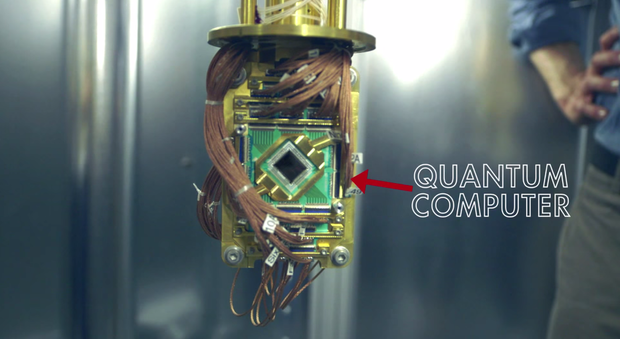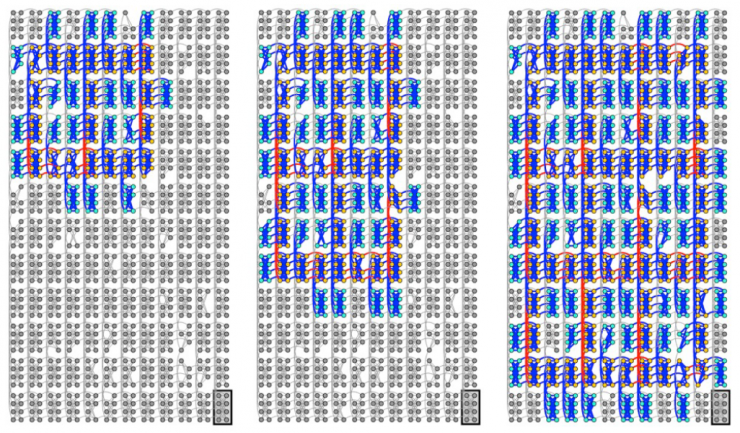Co-Building: Blake, Gao Fei

The Quantum Computer is a device that uses quantum logic for general-purpose computing. Unlike electronic computers (or traditional computers), the objects that quantum computers use to store data are qubits, which use quantum algorithms for data manipulation.
We may be far from truly unlocking the true power of quantum computing, but D-Wave promises to let us taste the future with its dramatically upgraded quantum processor.
When it was released early next year, the Canadian company's new quantum chip will be able to handle 2000 qubits of data (qubits), which is almost twice the number of processors available in the existing D-Wave 2X system, while being able to compare to previous generations. Product processing speed is 1000 times faster.
D-Wave machines are multi-million dollar computers that use "quantum transistors" to process data and use liquid nitrogen to cool small loops to absolute zero. Only a few places are using this system, including Google and the Universities Space Research Association, Lockheed Martin, and Los Alamos National Laboratory. In addition, D-Wave also provides cloud-based services that allow users to access its quantum computer system.
Quantum computing is still largely in the stage of theoretical research. Its main research is how to use the strange and counterintuitive way to develop very powerful machines at the atomic level. For some specific tasks, quantum computers have the potential to be many times faster than existing systems, while being more energy-efficient. However, general-purpose quantum computers do not exist yet. The D-Wave system uses different atomic behavior characteristics (such as entanglement and state superposition) to solve a series of difficult computational problems.
“The direction we choose to develop is very rapid, and the number of qubits will almost double every year,†said Colin Williams, D-Wave’s business development and strategic partner.
Boosting the qubits in the D-Wave processor brings the system closer to the ability to challenge traditional computers, while new processors also support the addition of new features (allowing more efficient computations).
"From an internal test point of view, this is a very worthwhile thing to do. By using this feature we have accelerated 1000 times to solve those existing problems." William of Cambridge CW TEC said.
The D-Wave system is not a universal computer if it is compared to today's computers.
D-Wave can do more than just any of the computing tasks you require. It is designed to handle specific tasks (such as unconstrained binary optimization and related sampling problems). A very simple example of this sort of optimization problem is that you have to develop a house plan that is as close as possible to the ideal conditions and details that you have in mind, but it should remain within your budget.
The specific work that the D-Wave processor can perform can also be applied to a range of fields, particularly training machine learning models .
However, the establishment of a universal quantum computer still has enormous difficulties. There are several unresolved engineering problems before us. UCL professor of nano-electronics and photonics John Morton by past trends chips projections, forecasting first-generation universal quantum computing processor will not appear until the 2030s.
John Morton mentioned that only one calculator cannot be called a computer, so the D-Wave system cannot be said to be a universal quantum computer. "A calculator solves many specific problems. Many people use it, and you can use it in different industrial fields. So when D-Wave shows that they can use their machines in many industrial fields , maybe it can be applied to this field, but it is still only a specific device."
Although Google does not currently use D-Wave in its own machine learning system, the credibility of the D-Wave processor (which has been questioned by academics) has been verified in an experiment last year by Google.
In Google's experiment, the annealing time required by D-Wave when processing the same amount of data is less than several orders of magnitude. The following figure shows simulated annealing method (SA), quantum Monte Carlo method and D-Wave 2X. Comparison of the time used for the annealing operation.

The experiment found that the D-Wave 2X processor was 100 million times faster than a conventional processor in performing similar operations , but Williams said that it is more important, which proves the feasibility of the D-Wave chip in the future.
The experiment also showed us the layout of several examples of the D-Wave 2X processor in dealing with weak-strong cluster network problems (see the figure below). The figure shows three different size networks 295,490,945 qubits. Each cluster consists of an 8-bit qubit unit of the Chimera diagram. The orange point describes a strong local field qubit, and the blue-green point represents the weak field qubit. The blue line represents strong magnetic coupling and the red line represents strong anti-magnetic coupling. Note that since not all 1152 qubits are operable, the resulting image may appear irregular.

"The main result of this experiment is not entirely an increase in speed, because other classical algorithms can do better. This experiment shows that quantum tunneling really occurs in the D-Wave chip. This shows that even if the tunneling range is Limited, it is still a useful computing tool."
"Google understands as much as we do that when we further make the chips more closely connected, the current well-run classic algorithms will fail completely," Williams added.
D-Wave has raised millions of dollars from many investors, including Goldman Sachs Investment Bank, In-Q-Tel (US Central Intelligence Agency Investment Department), Bezos Expeditions (Amazon founder Jeff Bezos) and BDC Capital , Harris & Harris Group and DFJ.
A machine that can imitate human speech
The D-Wave chip is too specialized and limits its usefulness. This is another critical point of view about this chip, but Willams does not agree with this view.
"I think the D-Wave chip is too single-purpose and I do not agree with this view. In fact, the application of this kind of chip in one area can be extended to more different areas, " he said.
Williams does not directly mention which companies use D-Wave chips in this way. He said that these processors are used in the commercial field to optimize trading trajectories, and in biological sciences to study how proteins are combined and constructed. The protein sequence filter allows accurate detection of every potential protein sequence. This application of the D-Wave chip helps to improve the screening service for detecting terrorists. It also helps to develop AI and computer vision binary classifiers.
However, the theoretical basis of the D-Wave chip is unsupervised machine learning , which provides training data for a neural network. The machine learns by identifying patterns . Williams believes that the D-Wave processor will have a huge impact and may explain Google's research interests in this field.
"We believe that machine learning and AI are the best application examples of this kind of machine. D-Wave chips will potentially bring about a complete revolution for machine learning, especially for unsupervised generation of learning research," he said. .
“Using this quantum chip, we will be able to address the previously challenging issues in the field of machine learning - 'How can unsupervised generative machine learning be effectively put into practical use?'â€
If you can solve the above problems, you will be able to use machine learning to achieve many incredible breakthroughs. By training the machine, you can make it generate new data. On the statistical level, the newly generated data can achieve highly similar results to the data used to train the machine itself.
Williams predicts that the future D-Wave chip can train machines, for example, using the work of a master painter to train machines, so that the machine can generate new works with artistic value, or enable the machine to imitate human voices with high fidelity.
D-Wave has experimented with machine learning on the chip to build a Boltzmann machine, a random recursive neural network, also called a " quantum Boltzmann machine, " Willams said. Quantum Boltzmann machines are essentially different from previous machine learning models."
Williams believes that D-Wave chips, or other types of quantum processors, will not replace some classic computer chips. Instead, they will be used in conjunction with these classic chips.
"We believe that quantum computing will not replace the classic machine, which will change the world by strengthening the classic system ," said Williams.
For example, you can obtain the output of a quantum computer and apply it as input to a heuristic search algorithm. The core point is that this quantum algorithm helps you approach and cannot find a good solution, while a classic algorithm can help to find the solution.
We can also pick a hard-to-solve problem from some preprocessing techniques and use this quantum chip to decompose the problem into a series of small problems.
Williams said that in addition to being able to handle 2000 qubits, D-Wave will use a new topology based on all the lessons we have learned to design a "next generation chip."
More details about the new D-Wave chip
Williams has provided in-depth explanations of the performance of 2,000 qubit chips for professionals interested in substantive issues.
Each D-Wave processor is designed for quantum annealing , which uses quantum physics knowledge to find a state that consumes minimal energy, which will help solve the optimization problem and the related sample problems mentioned above. Williams also explained in detail how this new chip can more effectively control the annealing process.
After referring to the Hamiltonian formula (using a formula that can output energy in the system given the state of a system), he said, "This new chip can not only handle more qubits, we have used them. It changed many other features.Using the previous D-Wave chip, we could only observe an annealing trace. At present, we can only basically close the initial Hamiltonian circuit and open the final Hamiltonian circuit."
Using a chip that can handle 2,000 qubits now, we will be able to better control the parameters and control the trajectory.
We can use many features to abort the annealing process and can quickly accelerate this process. It is no longer necessary to perform annealing at a constant rate.
This will be very interesting, because you can detect the state of the quantum during the annealing process, which is an extremely important feature of the quantum Boltzmann machine.
We also previously had a rapid annealing generation system that was able to complete the annealing process in 20 microseconds. However, using our new system, we can achieve this operation in 5 microseconds.
Recommended reading:
What is the Computational Value of Finite Range Tunneling?(quantum computing)
 On quantum computing chips, this company may be ahead of Google
This article was compiled by Lei Feng Network (search "Lei Feng Net" public number) , and refused to reprint without permission!
Via Nick Heath
We specialize in cable assembly overmolding. Our customized molded cables are built precisly following customers' spec.Experienced proposal can be offered to customers for evaluation by considering stable quality and competitive price.
we have internal design, prototype, and manufacturing the widest range of molded harnesses, also a diversified line of strain / flex reliefs and grommets.
Molded Cables,Stranded Round Molded Cables,Molded Patch Cord Cable,4 Pole Waterproof Molded Cable,Waterproof Connectors
ETOP WIREHARNESS LIMITED , http://www.oemmoldedcables.com